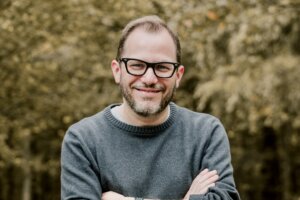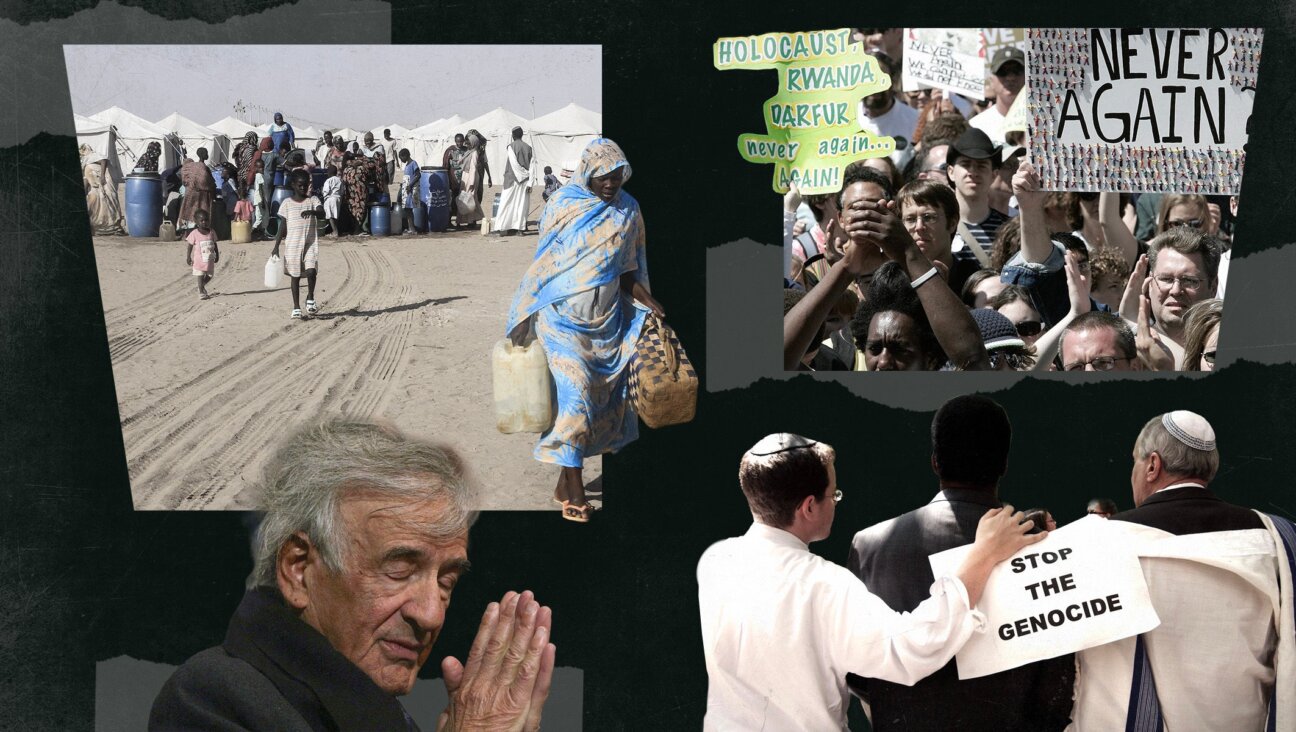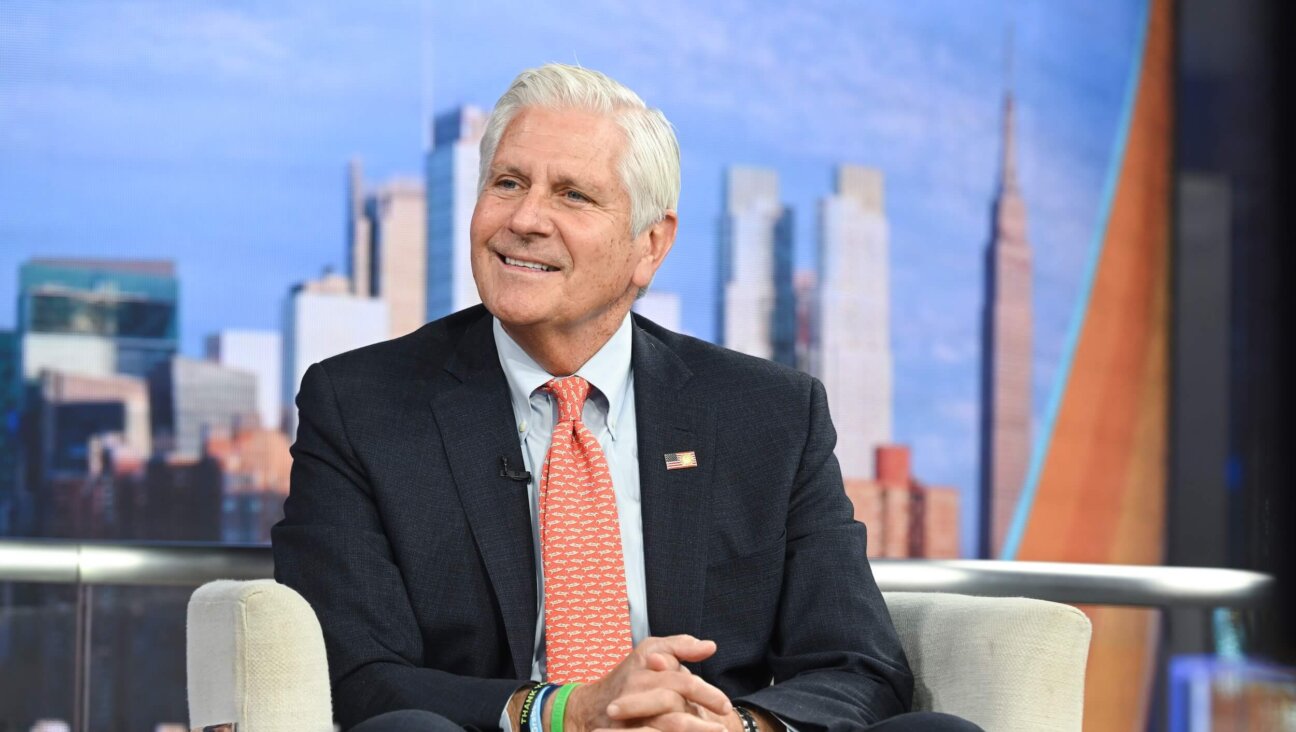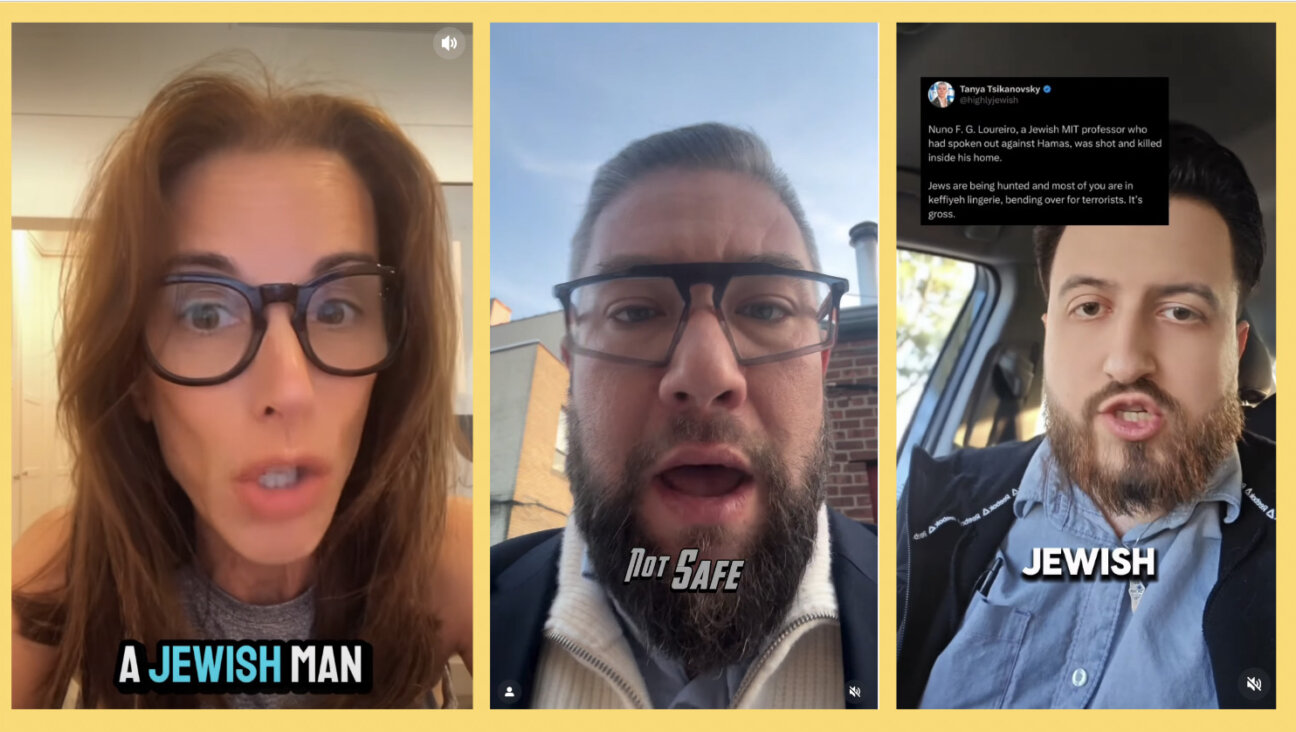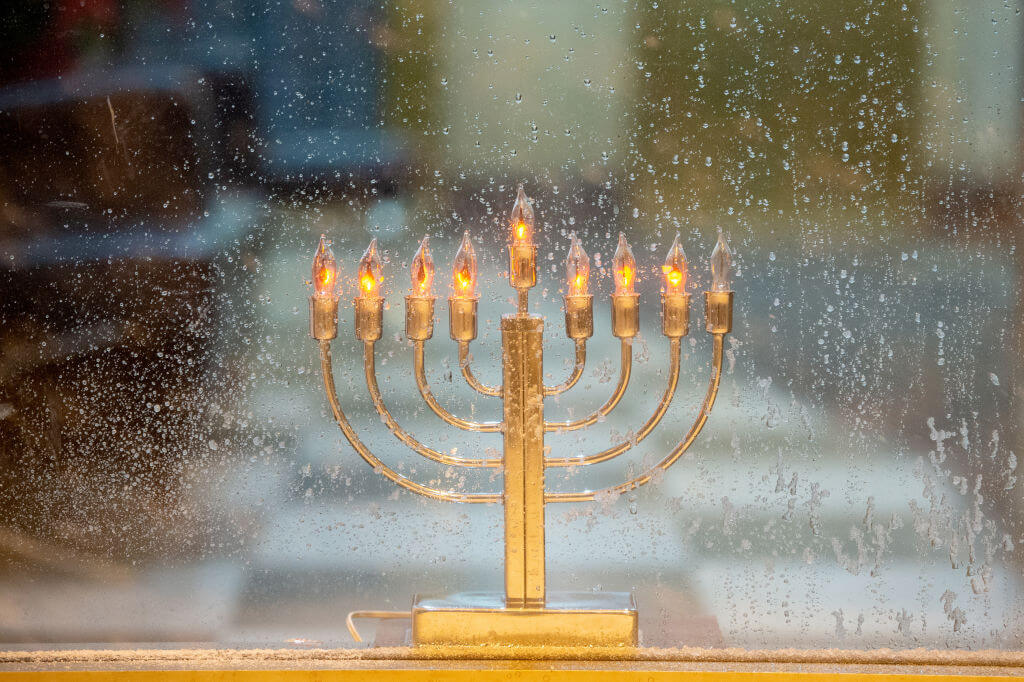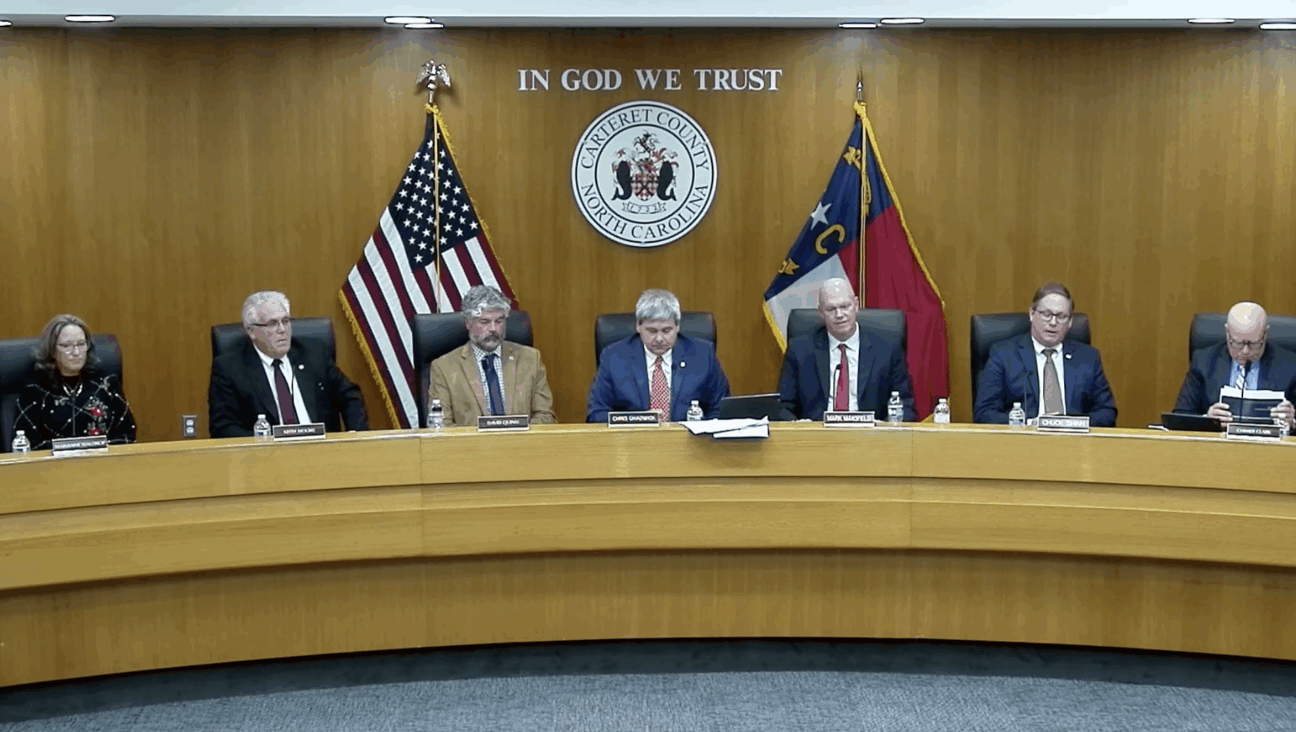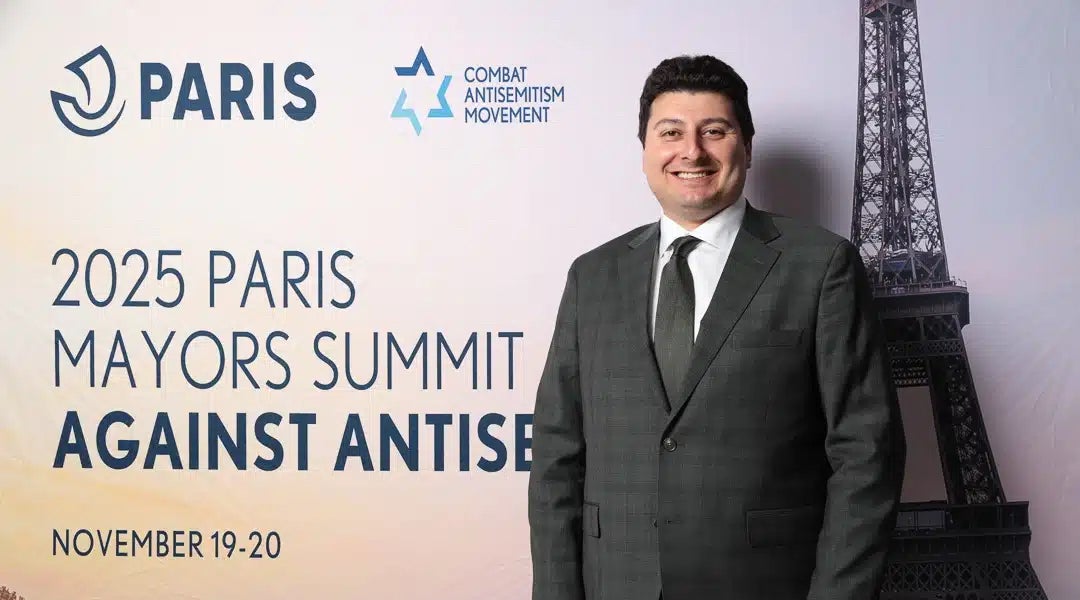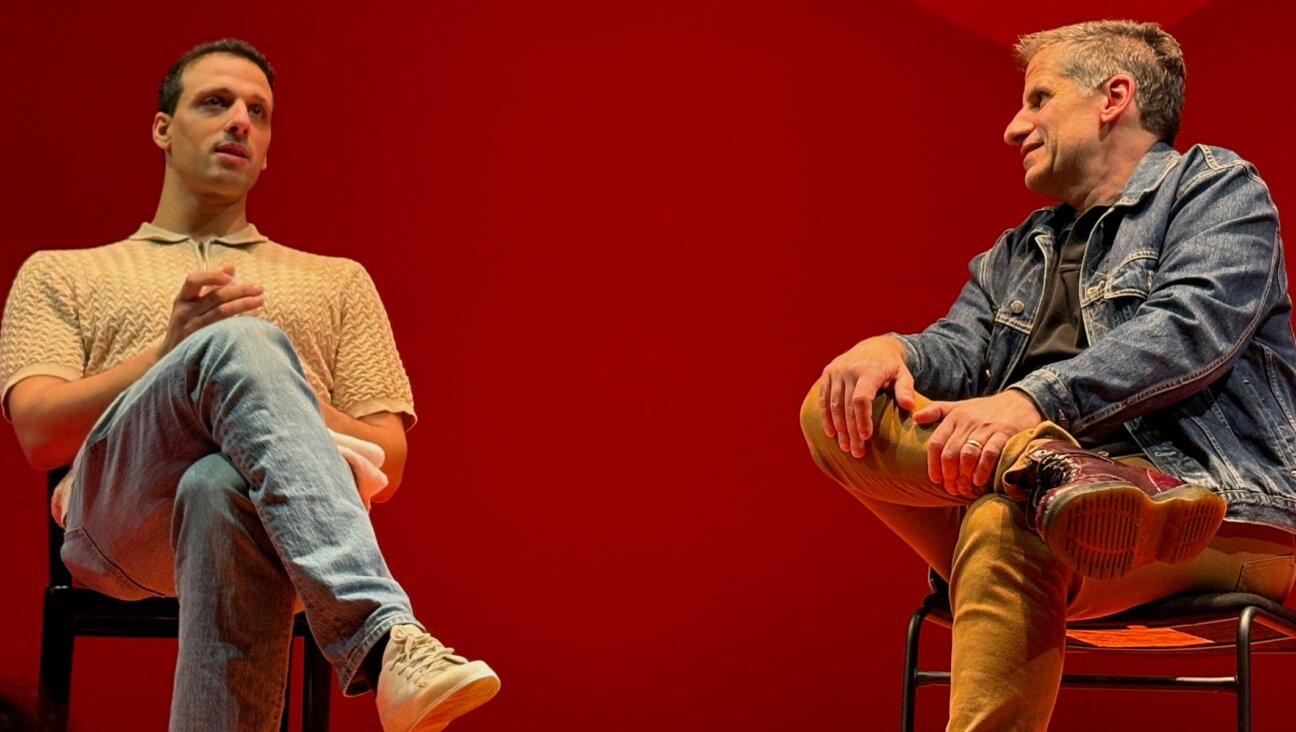He grew up Christian. Now he’s sleeping in the synagogue that sparked his conversion.
In a small Ohio town, a shuttered sanctuary sparked one man’s conversion — and a mission to preserve America’s overlooked Jewish past
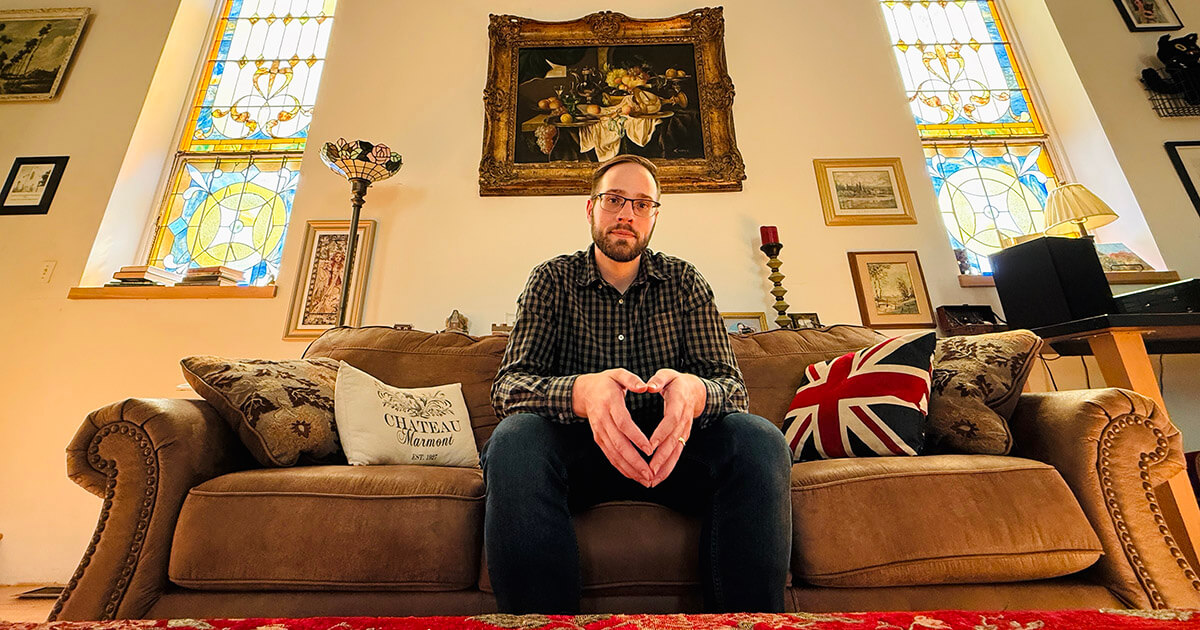
Austin Albanese in the former sanctuary of Congregation B’nai Israel in Lancaster, Ohio. Photo by Benyamin Cohen
Benyamin Cohen is the son of a rabbi and grew up with a synagogue in his house. He traveled to Lancaster, Ohio, to visit a century-old house of worship turned into an Airbnb.
LANCASTER, OHIO — Austin Albanese gave the front door of his Airbnb a shove and stepped into the sacred space he had imagined for most of his life, first as a Christian boy and now as a Jewish man.
Light streamed through tall stained-glass windows revealing a modern kitchen where a Torah ark once stood, a leather couch facing the ghost of Congregation B’nai Israel’s sanctuary, a binder on the coffee table titled The Legacy of 131 East Chestnut Street.
“I spent years trying to see inside this place,” said Albanese, 29, his voice belying a quiet awe.
Years earlier, at the local public library, he found a book stamped “Purchased through the B’nai Israel Endowment Fund.” That quiet gift — barely noticed on a library shelf — cracked open a world. A stamp, a spark, a summons. It sent him searching. He called it “a lightning bolt moment,” the beginning of a journey to becoming a Jew.
As a boy raised Christian, he’d walk past the building and ask his father why it was closed. “It was a synagogue,” his father said. “With men in little hats.”
That answer — simple, strange, incomplete — lodged in him like a seed. Albanese knew no Jewish families and had never been inside the building before. “And now I’m sleeping here,” he said, stretching out his arm across the vast space. “And I will be hosting my family here for dinner.”
This was no ordinary Airbnb. This was the only synagogue in Lancaster, Ohio. Today, it is a vacation rental at $358 a night. There is no ark, no yahrzeit plaques, no Torah scrolls — but the architecture still gestures toward holiness, with a vaulted ceiling, hand-hewn beams, and a history that hums beneath every floorboard. It reminds you that this was once a room where people asked something of God.
Where memory was made
Jewish congregations like B’nai Israel — small, rural, often Orthodox in structure but pluralistic in practice — once dotted the American interior. Many lacked full-time rabbis or large budgets. What they had, often, was a commitment to Jewish education and to civic life. In recent decades, scores have shuttered as populations shifted to cities and suburbs.
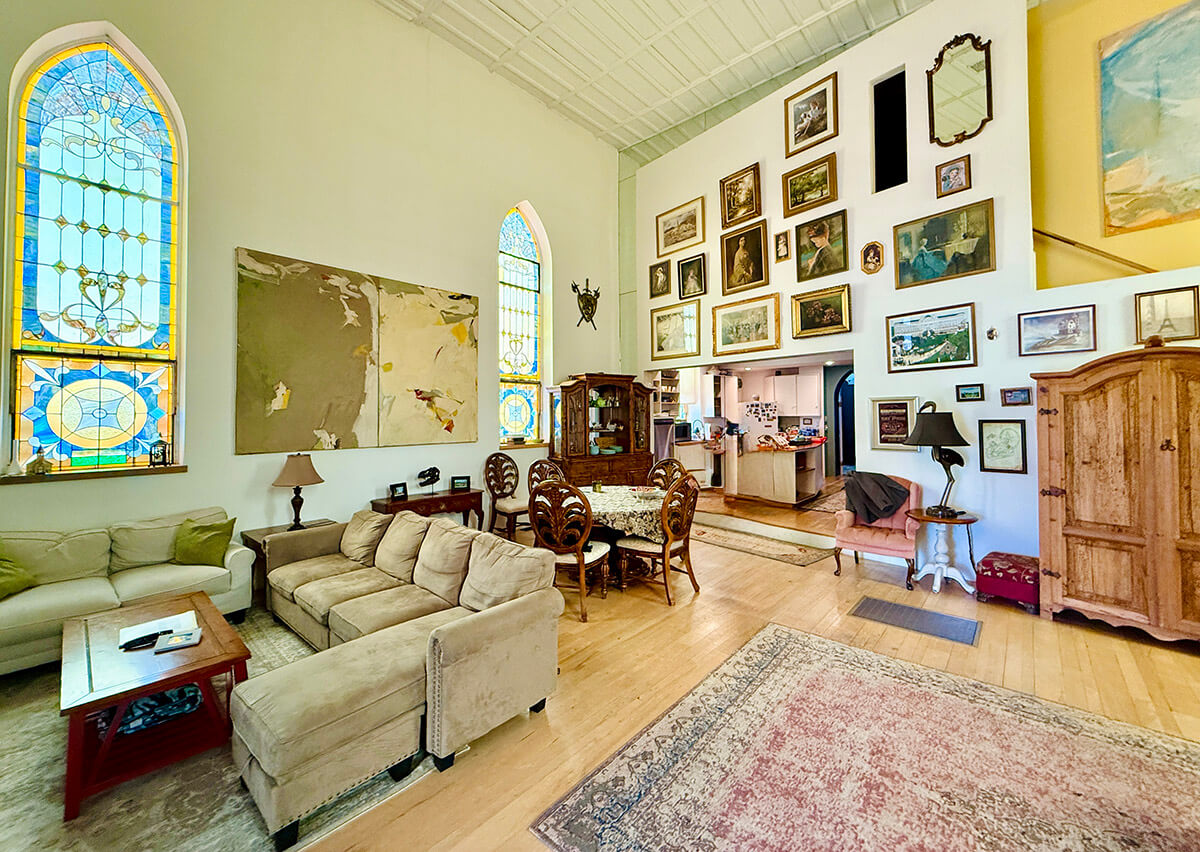
The building at 131 East Chestnut Street was constructed in 1851 and dedicated a year later as Emanuel Lutheran Church. The congregation eventually outgrew the space and moved to a larger facility, leaving behind a building whose bones still ached with the memory of hymns and Sunday sermons. In 1927, the Jewish community — roughly 60 people strong — raised $11,000 to buy the property. According to local newspaper accounts, more than 500 people crowded the sanctuary for the rededication. The mayor spoke. So did a local minister. It was, Albanese later discovered, one of the largest interfaith events in the town’s history, marking the first dedication of a non-Christian worship space in Lancaster. It remains the only non-Christian house of worship in Fairfield County’s history.
For decades, B’nai Israel thrived. The synagogue sisterhood raised money for the Red Cross, sewed blankets for newborns at the local hospital, and hosted community events. Children performed Purim plays. Services were Orthodox in form but interfaith in spirit. Clergy from other denominations visited. Church youth groups toured the sanctuary.
“These weren’t people who made contributions in only one space,” Albanese said of Lancaster’s Jews. “They were shaping the town.”
At its peak, the congregation likely had 100 members at most. It offered what most American synagogues do — just on a smaller, scrappier scale.
The synagogue’s longest-serving rabbi, Julius Baker, immigrated from Jedwabne, Poland — the site of a pogrom that killed hundreds. He brought a seriousness to Jewish learning that belied the congregation’s modest size. But when he left in 1957, B’nai Israel lost its educational backbone. Morris Molar, president since its founding, died in 1960. By then the congregation had aged, with the last bar mitzvah celebration in 1948.
Then came the fire.
In 1961, flames erupted from the basement furnace. The fire melted the stained-glass windows. It burned through prayer books and pews. But it didn’t touch the Torahs. Two members — Clarence Epstein and Jacob Molar — ran in and pulled them out. That rescue itself felt like a parable: of Jewish survival despite the odds.
The B’nai Israel congregation kept gathering for holiday services, with some driving 30 miles or more to participate. But the decline continued. By 1989, the final High Holiday services were held. Four years later, the building was sold to a family who converted it into a private home.
A faith not yet his
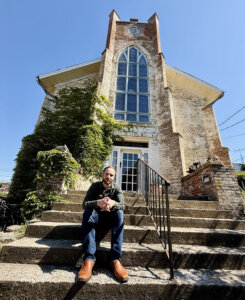
Albanese was born in 1996, three years after B’nai Israel shut its doors.
He never met the people who had prayed there, but he found their fingerprints. Those Jewish books at the library, donated and stamped with the name of a vanished congregation, stirred something in him. He began to read more, not just about history but about theology, ethics, ritual. The more he read, the more he wanted to understand what it meant to live Jewishly, to belong to this forgotten community, and to carry its story forward.
“Even though the congregation closed before I was born,” he said, “it was still teaching people.” He had missed them by a generation. But he found their ghosts — not haunting, exactly, just hovering.
He was baptized Lutheran and attended Catholic school. That tension between identities made him curious. “I always felt like I was in a religiously gray area,” he said.
There are children who grow up in churches and children who grow up around churches. Albanese, by his telling, was the latter. Enough distance to remain curious, not close enough to be bound. That’s often the start of belief — not in doctrine, but in yearning.
“That maybe made me more attuned to spiritual questions,” he said as we sat at the dining room table where the sanctuary used to be. The mystery became part of his faith, long before he had one.
Those questions grew louder. What was Judaism? Why had this synagogue existed in a place like Lancaster? And what had happened to the people who built it?
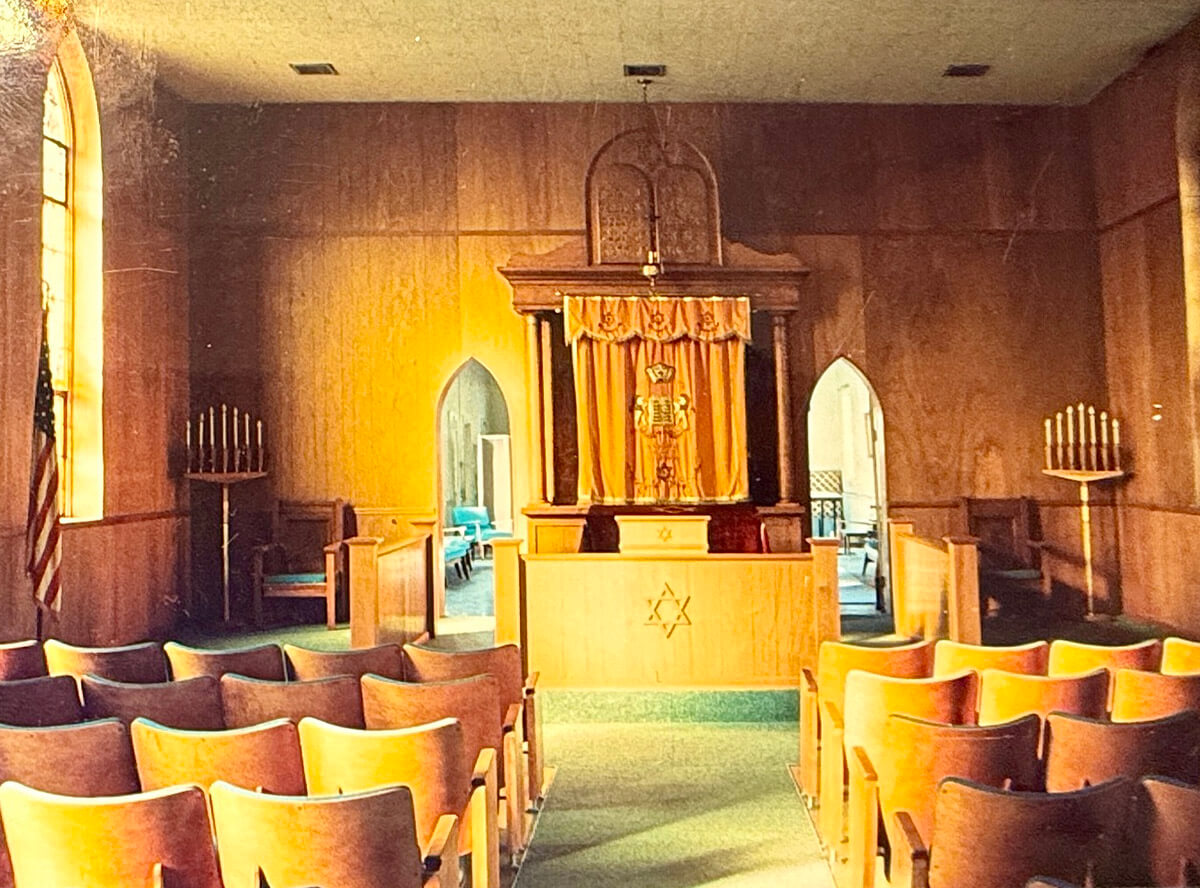
In college, at Capital University in Bexley — a Lutheran school in a heavily Jewish suburb of Columbus, Ohio — he found answers.
Albanese wasn’t Jewish yet. Not technically. But he was somehow already president of the Jewish student group, a job he took because no one else wanted it and because, secretly, he hoped it might make the religion feel more real. He organized a public Hanukkah lighting. Built a sukkah. Held a Passover Seder back in Lancaster — the town’s first public Jewish observance in more than a decade.
Around that time, a Catholic classmate gave him a Star of David necklace — the only piece of Judaica he owned for years. It wasn’t much, but he kept it close. A small symbol of a faith he hadn’t yet joined, but already felt tethered to.
In 2015, he formally converted and became a Jew.
“The rejection of original sin. The Jewish approach to forgiveness. The idea that you’re not required to forgive someone who’s still hurting you. These were liberating ideas,” he said.
Becoming the archivist
His personal journey became a spiritual calling. Since 2017, Albanese has documented more than 30 small-town Jewish communities, publishing articles about them on Substack and in local newspapers across the country, including The (Cleveland) Plain Dealer, The Knoxville News Sentinel and The Atlanta Journal-Constitution. He’s written about Jewish life in small Ohio towns: farmers near Ashtabula, Holocaust survivors in Fremont, two synagogues in Mansfield — one Orthodox and one non-Orthodox — that once shared a space. In many cases, his work is the only written record of those congregations’ existence.
“In the absence of a biological Jewish family,” he said, “I’ve remembered Jews who once lived in towns like my own. It’s a commitment, a way to create meaning through zachor, remembrance, an imperative that appears nearly 200 times in the Hebrew Bible.”
What struck him most, he said, was not just the lives of the Jews in these towns — but the support they received from non-Jews.
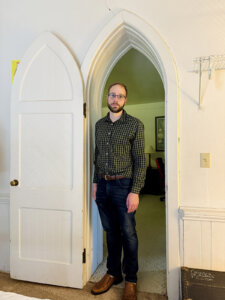
“The birth of Jewish life in so many places in America was accompanied by interfaith partnership and solidarity,” he said. “Not just showing up in curiosity for a dedication service, but donating money to help build the synagogue, enrolling non-Jewish children in Jewish schools to help make them financially sustainable. And when there would be a fire — as happened here at B’nai Israel — a church nearby offered to open up its sanctuary so the community could still worship.”
And those moments of solidarity — however quiet — still echo in the towns where Jewish life once flourished.
“One thing that’s given me a particular joy is seeing places like Bucyrus, Ohio, that today have absolutely no Jewish presence I’m aware of, but still, their historical societies choose to profile these stories of Jewish families from generations ago, and the library has a public exhibit about it,” he said. “Seeing how even when these communities are gone for decades, locals still care. They care to know who these people were, and they care about the legacies and how they’ve shaped the town.”
Those moments — when a town remembers its Jewish neighbors long after they’re gone — are what keep Albanese going. They’re proof, he said, that these histories still matter. Not just locally, but nationally.
“What I’m hoping to do is say not only why these histories matter in the local sense, but are there still lessons that larger Jewish communities can learn from small towns, even after their presence fades?”
He believes there is.
“Memory can be preserved beyond the life of the congregation,” he said. “And I think there are other communities that could really benefit from that message too.”
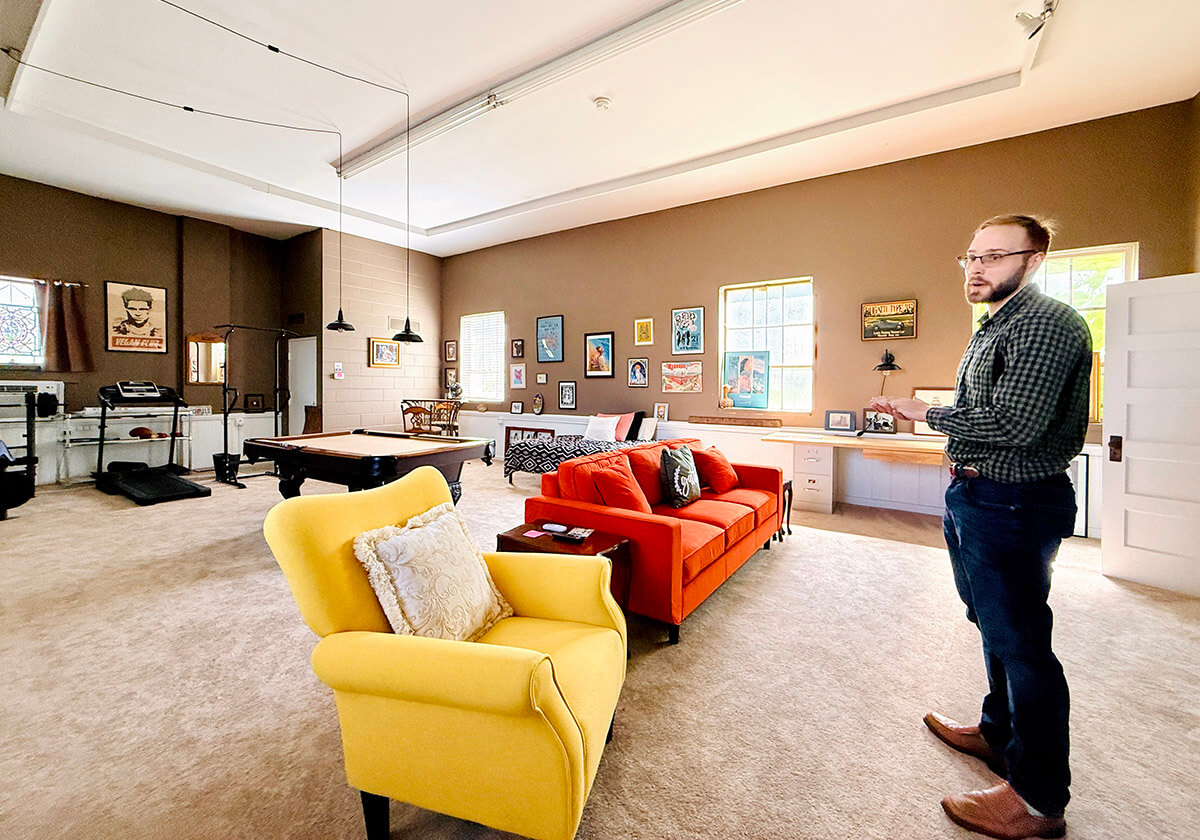
“So many of these stories aren’t about decline,” he said. “They’re about hospitality. About coexistence. About people building something together, often across faiths. And even when the congregations fade, the values don’t always disappear.”
One of those values is remembrance. Albanese volunteers with the chevra kadisha, the ancient Jewish burial society. He helps prepare bodies for burial. He recites prayers. Washes limbs. Wraps the dead in white linen.
In Judaism, preparing the dead is considered an act of loving kindness — a sacred duty performed in silence and anonymity. The work of the chevra kadisha gave him a way to touch history — not just read it. “It was my way of connecting to Jewish generations before me,” he said.
He sees his writing the same way.
“When I write about a Jewish family in Chauncey, Ohio, where my own family lived, I think: they may have swam in the same creek I did. Walked the same streets. Done the same jobs. I didn’t grow up with these stories. But I can help carry them.”
A house full of echoes
Albanese booked the Airbnb for the Fourth of July weekend. He wanted to be here on a day when the town swelled with pride — flags in windows, families in lawn chairs, a celebration of country that let him better understand the place, and the people who built this sacred space.
Main Street buzzed with brass bands and bunting as the holiday parade began, sunburned kids with sticky fingers waving flags. A pickup truck pulling a float draped in red, white and blue. Firefighters tossing candy.

Albanese looked toward the post office, where his grandfather had spent his career fixing the sorting machines that kept the town’s daily churn in motion. “He worked here his whole life,” he said.
In the town square, we stopped at the war memorial honoring Lancaster’s veterans. A cross was etched into one side. Next to it, a Star of David.
“That star represented someone,” Albanese said. “And as a kid, I didn’t know who.”
He does now.
As part of a college project, Albanese wrote a history of B’nai Israel, including details about the building. Years later, he gave an updated version to the owners, who printed and bound it for guests to read.
A few days after he left, Albanese learned the building was going up for sale. The 4,000-square-foot 19th-century former synagogue was recently listed for $450,000.
The timing spoke to Albanese of impermanence and the importance of memory.
“It’s totally surreal,” he said. “I keep thinking how narrow the window was — how close the story of this place came to disappearing. And yet somehow, it opened just wide enough for the story to find us. To speak, and be remembered.”
